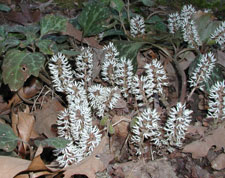Resource Library
Plant of the Week: Spurge, Allegheny
The University of Arkansas System Division of Agriculture does not promote, support or recommend plants featured in "Plant of the Week." Please consult your local Extension office for plants suitable for your region.
Plant of the Week
Allegheny Spurge
Latin: Pachysandra procumbens

Gardens have one thing in common. As they age, they become shadier. Shade is a good thing for us humans, but it seriously cuts down on the plants we can grow.
Many woodland plants hide out during the summer, going dormant as trees suck the moisture from the soil and reduce the sunlight to subsistence levels. But a few tough woodlanders such as Allegheny spurge (Pachysandra procumbens) tolerate both drought and shade making them great additions to the shade garden.
Allegheny spurge is a native woodland plant of our eastern forests, ranging down the Appalachian chain from Pennsylvania to northern Georgia in rich woodland sites. Technically it is considered an evergreen sub-shrub in the boxwood family, though it behaves like an herbaceous perennial. South of zone 6 it is evergreen; north of there deciduous. Plants grow from a slowly expanding crown, reaching 10 inches tall with an outward sprawl of two feet.
Pachysandra has erect stems with individual leaves alternately arranged near the ends of these branches. The clustered arrangement gives the illusion of a compound leaf, but that is not the case. The leaves are slightly pubescent, ovate in outline and 3 inches long. In the summer the foliage is blue green, a bit dull looking due to its pubescence, and not particularly noteworthy. But as fall arrives the leaves turn blotched shades of chocolate, silver and green; the color persisting until spring when new leaves appear as the plant flowers.
The fragrant flowers appear in early spring as erect whitish to purplish-green 4-inch long spikes arising directly from the center of the crown. The flowers, best described as interesting rather than beautiful, have no petals and the sepals too are small, arranged in a tight cluster at the base of each cluster of stamens. The showy part of the spike is a set of four fat, rather large stamens at the top of the spike; the female pistil is at the base of the spike. The genus name translates from Latin as “fat anthers.”
This species is less common in gardens than its Asian cousin, Pachysandra terminalis. Whereas the Asian species has a reputation of taking over a garden if not periodically restrained, Allegheny pachysandra is relatively slow growing and stays pretty much where planted. One writer describes our native species as having “dingy color” compared to the shiny leaves of the more commonly grown species. But all that glossy green exuberance looks a bit out of place in a naturalized woodland setting whereas Allegany spurge looks at peace.
Another big difference between the two is the rate of spread. Japanese pachysandra has the reputation of taking over a garden, pushing out slow growing neighbors as it sends its rhizomes into new territory.
By comparison the Alleghany Spurge is down right slow growing. In my garden, Japanese pachysandra has spread from a single planting to cover about 20 square feet in five years. The Alleghany pachysandra plantings have grown well but only occupy about one-fourth of that area.
If your goal is to cover the back yard in green, Japanese pachysandra is a good choice. But, if you want something to plant amongst the other plants in the shade garden, the native pachysandra is a better choice.
Allegheny spurge occurs naturally in moist, humus rich soil in deciduous woodlands. Replicating the soil conditions is not an absolute requirement, for I grow it in heavy clay amended with compost. It will be faster growing and somewhat larger if given good soil. It tolerates full sun but leaf size will be reduced and burning may occur in the hottest period of summer. There are no serious insect or disease problems.
By: Gerald Klingaman, retired
Extension Horticulturist - Ornamentals
Extension News - May 4, 2007
The University of Arkansas System Division of Agriculture does not maintain lists of retail outlets where these plants can be purchased. Please check your local nursery or other retail outlets to ask about the availability of these plants for your growing area.